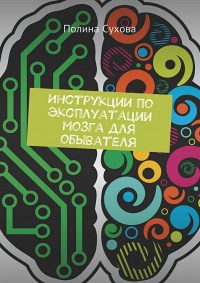Ознакомительная версия. Доступно 14 страниц из 70
46. J. A. Pratt, C. Winchester, A. Egerton, S. M. Cochran, and B. J. Morris, «Modelling Prefrontal Cortex Deficits in Schizophrenia: Implications for Treatment», British Journal of Pharmacology 153 (2008): 465–470; C. E. Bearden, K. M. Hoffman, and T. D. Cannon, «The Neuropsychology and Neuroanatomy of Bipolar Affective Disorder: A Critical Review», Bipolar Disorders 3 (2001): 106–150; A. Anticevic, M. S. Brumbaugh, A. M. Winkler, L. E. Lombardo, J. Barrett, P. R. Corlett, H. Kober, J. Gruber, G. Repovs, M. W. Cole, J. H. Krystal, G. D. Pearlson, and D. C. Glahn, «Global Prefrontal and Fronto-Amygdala Dysconnectivity in Bipolar I Disorder with Psychosis History», Biological Psychiatry 73 (2013): 565–573; Y. I. Sheline, J. L. Price, Z. Yan, and M. A. Mintun, «Resting-State Functional MRI in Depression Unmasks Increased Connectivity Between Networks Via the Dorsal Nexus», Proceedings of the National Academy of Sciences 107 (2010): 11020—11025.
47. Q. Xiao, Y. Zhong, D. Lu, W. Gao, Q. Jiao, G. Lu, and L. Su, «Altered Regional Homogeneity in Pediatric Bipolar Disorder During Manic State: A Resting-State FMRI Study», PLoS ONE 8 (2013): E57978.
48. S. Carson, «Creativity and Psychopathology», in Neuroscience of Creativity, Eds. O. Vartanian, A. S. Bristol, and J. C. Kaufman (Cambridge, MA: MIT Press, 2013).
49. S. Whitfield-Gabrieli, H. W. Thermenos, S. Milanovic, M. T. Tsuang, S. V. Faraone, R. W. McCarley, M. E. Shenton, A. I. Green, A. Nieto-Castanon, P. la Violette, J. Wojcik, J. D. E. Gabrieli, and L. J. Seidman, «Hyperactivity and Hyperconnectivity of the Default Network in Schizophrenia and in First-degree Relatives of Persons with Schizophrenia», Proceedings of the National Academy of Sciences USA 106 (2009): 1279–1284.
50. См. ссылку на TED Talk на тему влияния школы на креативность: www.ted.com/ talks/ken_ robinson_ says_ schools_ kill_ creativity?language=en.
51. Очень подробный обзор этой программы можно найти здесь: R. L. DeHaan, «Teaching Creativity and Inventive Problem Solving in Science», NCBE Life Sciences Education 8 (2009): 172–181.
52. Более подробное описание программы здесь: E. Bodrova and D. J. Leong, Tools of the Mind: The Vygotskian Approach to Early Childhood Education, 2nd edn. (New York: Pearson, 2006); also see: http:// toolsofthemind.org.
53. R. Van der Veer and J. Valsiner, Eds., The Vygotsky Reader, 1st edn. (Hoboken, NJ: Wiley-Blackwell, 1994); подробнее о странной судьбе этой статьи можно найти в кн.: E. Goldberg, The Wisdom Paradox: How Your Mind Can Grow Stronger as Your Brain Grows Older (New York: Gotham Books, 2005); и в кн.: E. Goldberg, «Thank You for Sharing This Fascinating Material— Very Interesting», Dubna Psychological Journal 5 (2012): 118–120.
54. A. Diamond, W. S. Barnett, J. Thomas, and S. Munro, «Preschool Program Improves Cognitive Control», Science 318 (2007): 1387–1388; A. Diamond and K. Lee, «Interventions Shown to Aid Executive Function Development in Children 4—12 Years Old», Science 333 (2011): 959–964; C. Blair and C. C. Raver, «Closing the Achievement Gap Through Modification of Neurocognitive and Neuroendocrine Function: Results from a Cluster Randomized Controlled Trial of an Innovative Approach to the Education of Children in Kindergarten», PLoS One 9 (2014): E112393.
55. Более подробную информацию о «Школах Минервы» можно найти здесь: www.minerva.kgi.edu; www.youtube.com/ watch?v=5-NRAg0_ y1I.
Глава 10. Креативный мозг
1. S. F. Witelson, D. L. Kigar, and T. Harvey, «The Exceptional Brain of Albert Einstein», The Lancet 353 (1999): 2149–2153.
2. D. Falk, F. E. Lepore, and A. Noe, «DOI the Cerebral Cortex of Albert Einstein: A Description and Preliminary Analysis of Unpublished Photographs», Brain (2012): 1304–1327.
3. W. Men, D. Falk, T. Sun, W. Chen, J. Li, D. Yin, L. Zang, and M. Fan, «The Corpus Callosum of Albert Einstein’s Brain: Another Clue to His High Intelligence?» Brain 137 (2013): 1–8.
4. M. C. Diamond, A. B. Scheibe, G. M. Murphy, and T. Harvey, «On the Brain of A Scientist: Albert Einstein», Experimental Neurology 88 (1985): 198–204.
5. O. S. Adrianov, I. N. Bogolepova, S. M. Blinkov, L. A. Kukuev, «The Study of V. I. Lenin’s Brain», [article in Russian] Uspekhi Fiziologicheskikh Nauk 24 (1993): 40–52.
6. See link for more on Gauss’s brain: https:// www.mpg.de/ 7589532/ Carl_Friedrich_ Gauss_ brain; R. Schweizer, A. Wittmann, J. Frahm, «A Rare Anatomical Variation Newly Identifies the Brains of C. F. Gauss and C. H. Fuchs in a Collection at the University of Gottingen», Brain 137 (2013): 1–2.
7. A. Dietrich and N. Srinivasan, «The Optimal Age to Start a Revolution», The Journal of Creative Behavior 41 (2007): 54–74.
8. E. S. Finn, X. Shen, D. Scheinost, M. D. Rosenberg, J. Huang, M. M. Chun, X. Papademetris, and R. T. Constable, «Functional Connectome Fingerprinting: Identifying Individuals Using Patterns of Brain Connectivity», Nature Neuroscience 18 (2015): 1664–1671; M. D. Rosenberg, E. S. Finn, D. Scheinost, X. Papademetris, X. Shen, R. T. Constable, and M. M. Chun, «A Neuromarker of Sustained Attention from Whole-Brain Functional Connectivity», Nature Neuroscience 19 (2016): 165–171.
9. Y. Li, Y. Liu, J. Li, W. Qin, K. Li, C. Yu, and T. Jiang, «Brain Anatomical Network and Intelligence», PLoS Computational Biology 5 (2009): E1000395.
10. D. J. Smit, C. J. Stam, D. Posthuma, D. I. Boomsma, and E. J. De Geus, «Heritability of «Small-World» Networks in the Brain: A Graph Theoretical Analysis of Resting-State EEG Functional Connectivity», Human Brain Mapping 29 (2008): 1368–1378.
11. L. Wang, C. Zhu, Y. He, Y. Zang, Q. J. Cao, H. Zhang, Q. Zhong, and Y. Wang, «Altered Small-World Brain Functional Networks in Children with Attention-Deficit/ Hyperactivity Disorder», Human Brain Mapping 30 (2009): 638–649.
12. E. M. Miller, «Intelligence and Brain Myelination: A Hypothesis», Personality and Individual Differences 17 (1994): 803–832.
13. J. M. Fuster, The Neuroscience of Freedom and Creativity: Our Predictive Brain (Cambridge, UK: Cambridge University Press, 2013): 176.
14. E. R. Sowell, B. S. Peterson, P. M. Thompson, S. E. Welcome, A. L. Henkenius, and A. W. Toga, «Mapping Cortical Change Across the Human Life Span», Nature Neuroscience 6 (2003): 309–315; F. I. M. Craik and E. Bialystok, «Cognition Through the Lifespan; Mechanisms of Change», Trends in Cognitive Sciences 10 (2006): 131–138.
15. D. J. Millera, T. Dukaa, C. D. Stimpson, S. J. Schapiro, W. B. Baze, M. J. McArthur, A. J. Fobbs, A. M. M. Sousa, N. Sestan, D. E. Wildman, L. Lipovich, C. W. Kuzawa, P. R. Hof, and C. C. Sherwood, «Prolonged Myelination in Human Neocortical Evolution», Proceedings of the National Academy of Sciences 109 (2012): 116480—16485.
16. L. Marner, J. R. Nyengaard, Y. Tang, and B. Pakkenberg, «Marked Loss of Myelinated Nerve Fibers in the Human Brain with Age», Journal of Comparative Neurology 462 (2003): 144–152.
Ознакомительная версия. Доступно 14 страниц из 70
























